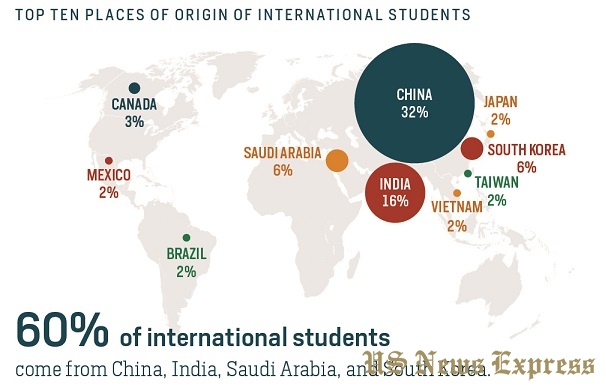NEW YORK, November 13, 2017—According to the 2017 Open Door Report on International Educational Exchange data released today by IIE and the U.S. Department of State Bureau of Educational and Cultural Affairs, the number of international students in the United States increased by three percent over the prior year, and the number of American students studying abroad increased by four percent from the prior year.

In 2016/17, for the second consecutive year, U.S. colleges and universities hosted more than one million international students, reaching a record high of 1.08 million. This also marks the eleventh consecutive year of continued expansion of the total number of international students in U.S. higher education.
While the overall number of international students studying in the United States has increased, the number of new international students—those enrolled at a U.S. institution for the first time in fall 2016, declined by nearly 10,000 students to about 291,000, a three percent decrease from the previous year. This is the first time that these numbers have declined in the twelve years since Open Doors has reported new enrollments.
The factors driving the slowing of growth include a mix of global and local economic conditions, and in some cases expanded higher education opportunities at home and declining populations. The scaling back of large Saudi and Brazil government scholarship programs were a significant factor, as the number of students from those two countries showed the biggest decreases, particularly in non-degree study. Much of the increase reported for the past couple of years can be attributed to more students pursuing Optional Practical Training (OPT) related to their academic fields after their degree studies, and thus remaining longer in the U.S. higher education system. These flattening trends have a nearly two year history, as students reflected in the current Open Doors report were already on campus in September 2016 for the fall term, and most had applied in 2015 and made their decisions in spring 2016.
IIE conducted a separate online fall enrollment survey with nine other education associations in September and October 2017 to provide an early look at what campuses are seeing now for the current 2017/18 academic year. The nearly 500 colleges and universities responding reported continued flattening in the overall number of enrolled students and an average decrease of 7 percent in the number of new enrolled students.
But these numbers were not evenly distributed: 45 percent of the campuses reported declines in new enrollments for fall 2017, while 31 percent reported increases in new enrollments and 24 percent reported no change from last year.
International students benefit U.S. communities, colleges and universities, in many ways, including economically. In 2016 international students brought $39 billion to the United States economy, through their spending on tuition, room and board and living expenses, according to the U.S. Department of Commerce. Their roles on campus as teaching and research assistants support the faculty in many departments, especially in STEM fields (Science, Technology, Engineering and Math), and their diverse perspectives help enrich classroom learning for U.S. students.
While this year’s Open Doors report shows strong growth in the number of international students studying in the United States in the past decade, with an increase of 85 percent since 2006/07 (when there were fewer than 600,000 international students in U.S. higher education), the new findings signal a slowing of growth, with a three percent increase compared to increases of 7 to 10 percent for the previous three years.
Top Places of Origin and Host States for International Students in the U.S.
The top places of origin for international students studying in the United States were China, India, South Korea, Saudi Arabia, Canada, Vietnam, Taiwan, Japan, Mexico, and Brazil. The top host states were California, New York, Texas, Massachusetts, Illinois, Pennsylvania, Florida, Ohio, Michigan, and Indiana. Each of these states saw increases in international students in 2016/17.
Academic Levels
Open Doors 2017 reports that modest increases in the numbers of international students pursuing undergraduate and graduate degrees were partially offset by a decrease of 14 percent in the numbers enrolled in non-degree programs, including short-term exchanges and intensive English language programs. The number of students staying on after graduation for 12 to 36 months of OPT rose by 19 percent to more than 175,000 students, indicating a strong desire by international students to gain valuable career skills and connections before returning home.
Americans Studying Abroad
The report shows that 325,339 American students received academic credit last year at the home campus for study abroad in 2015/2016, an increase of four percent from the previous year. Study abroad by American students has more than tripled in the past two decades; however, the rate of growth had slowed following the financial crisis in 2008. The population of U.S. students studying abroad continues to diversify, with greater inclusion of students from underrepresented racial and ethnic backgrounds.
U.S. higher education is increasingly focused on preparing U.S. students to secure jobs after graduation in order to advance their careers, as well as preparing them to thrive in the multicultural global marketplace. Studies have shown that studying abroad helps students develop the skills needed to succeed in today’s interconnected world.
Top Destinations
The top host destinations for U.S. students studying abroad in 2015/16 were the United Kingdom, Italy, Spain, France, and Germany. China dropped out of the top five host countries, as the number of U.S. students studying there decreased by 9 percent. Europe was the top host region, attracting more than 50 percent of Americans who studied abroad, followed by Latin America and the Caribbean, and Asia. Strong growth was noted in Australia, Czech Republic, Cuba, Denmark, Germany, Ireland, Japan, Mexico, the Netherlands, New Zealand, and South Africa.
Top Majors
Twenty-five percent of all students who studied abroad were majoring in STEM fields at their home institution, a number which has been growing faster than the average, followed by Business, Social Sciences, Foreign Language and International Studies, and Fine and Applied Arts.



















